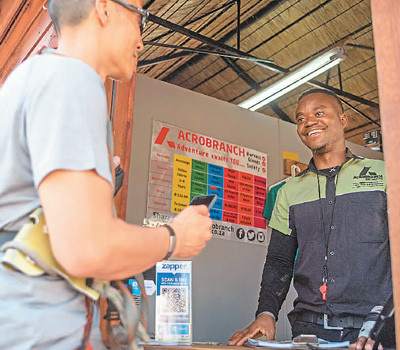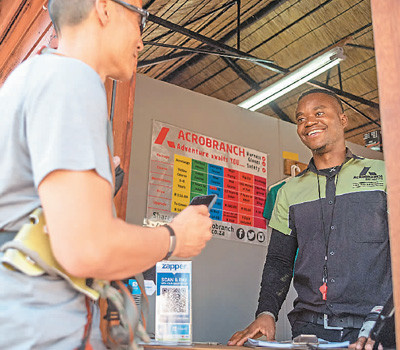By Pan Xutao from People’s Daily

A tourist pays for a rope course using Alipay in Johannesburg, South Africa. (Photo by Xinhua News Agency)
E-commerce will prosper among the BRICS countries and connect people of the five countries, a report by Alibaba Group Holdings released on August 29 said.
Chinese products are popular in Brazil. Echello and Biya, a Brazilian couple, told People’s Daily that Chinese products are cost-effective.
The couple has over 500,000 followers on their social media platform, on which they often share apparel and digital products they bought from Chinese e-commerce platforms.
The Alibaba report found that Chinese consumers are increasingly drawn to Russian candies, Indian handicrafts, Brazilian flip flops and grapefruit from South Africa, while customers in the four countries are most attracted to Chinese apparel and mobile phones.
Russian girl Chistyakova started using Chinese online shopping platforms three years ago when she saw an advertisement about a skirt on AliExpress, Alibaba’s export subsidiary for overseas buyers. The low price of the skirt impressed her and she has been shopping on Chinese e-commerce platforms ever since.
Now, Chistyakova regularly buys panty hoses and dresses on AliExpress and her husband, Oleg, has become a frequent buyer of hard disks and other computer accessories. Chistyakova said the cell phones she and her husband bought on the platform are very easy to use.
According to the Russian e-commerce association, in 2016, about 245 million more parcels were shipped to Russian online consumers, with China having a 90 percent share.
Many Russian consumers now regard Singles Day, which falls on November 11, as a big day for online shopping. The Russian banking system once broke down due to the large number of transactions during a Singles Day promotion. According to Tmall International, in 2016, the gross volume of Russian goods generated via the portal was 34 times that of 2015.
Havana, a well-known flip flop brand in Brazil, found its way into Tmall at the beginning of 2013. As of this July, over one million Havana flip flops have been sold to Chinese consumers. The company has expanded production because of the good sales, which generated more income for Brazilian rubber growers.
BRICS countries have been exploring more opportunities for e-commerce cooperation. In 2015, the BRICS leaders endorsed the Framework for BRICS E-commerce Cooperation to promote the construction of an integrated market among BRICS countries.
At the start of August, BRICS trade ministers approved a proposal for BRICS e-commerce cooperation, formally kicking off the cooperative process.
The Alibaba report said e-commerce is set to prosper among BRICS countries. In 2016, the number of online shoppers from the five countries reached 1.46 billion, 42.7 percent of the global total. The gross merchandise volume generated via online shopping portals hit $876.1 billion, 47 percent of the world’s total.
By 2022, gross merchandise volume generated via online shopping portals will reach about $3 trillion in Brazil, Russia, India, China and South Africa, 59 percent of the world’s total, the report projected.
Zhong Shan, China's Minister of Commerce, recently said Chinese people will soon see more food on their table from Brazil, Russia, India and South Africa.
Chinese businesses will carry out more cooperation with other BRICS countries in terms of e-commerce sales, logistics and payments, he said, adding that it is predictable that e-commerce will serve as the new impetus to promote economic and trade cooperation among BRICS countries.
Chinese products are popular in Brazil. Echello and Biya, a Brazilian couple, told People’s Daily that Chinese products are cost-effective.
The couple has over 500,000 followers on their social media platform, on which they often share apparel and digital products they bought from Chinese e-commerce platforms.
The Alibaba report found that Chinese consumers are increasingly drawn to Russian candies, Indian handicrafts, Brazilian flip flops and grapefruit from South Africa, while customers in the four countries are most attracted to Chinese apparel and mobile phones.
Russian girl Chistyakova started using Chinese online shopping platforms three years ago when she saw an advertisement about a skirt on AliExpress, Alibaba’s export subsidiary for overseas buyers. The low price of the skirt impressed her and she has been shopping on Chinese e-commerce platforms ever since.
Now, Chistyakova regularly buys panty hoses and dresses on AliExpress and her husband, Oleg, has become a frequent buyer of hard disks and other computer accessories. Chistyakova said the cell phones she and her husband bought on the platform are very easy to use.
According to the Russian e-commerce association, in 2016, about 245 million more parcels were shipped to Russian online consumers, with China having a 90 percent share.
Many Russian consumers now regard Singles Day, which falls on November 11, as a big day for online shopping. The Russian banking system once broke down due to the large number of transactions during a Singles Day promotion. According to Tmall International, in 2016, the gross volume of Russian goods generated via the portal was 34 times that of 2015.
Havana, a well-known flip flop brand in Brazil, found its way into Tmall at the beginning of 2013. As of this July, over one million Havana flip flops have been sold to Chinese consumers. The company has expanded production because of the good sales, which generated more income for Brazilian rubber growers.
BRICS countries have been exploring more opportunities for e-commerce cooperation. In 2015, the BRICS leaders endorsed the Framework for BRICS E-commerce Cooperation to promote the construction of an integrated market among BRICS countries.
At the start of August, BRICS trade ministers approved a proposal for BRICS e-commerce cooperation, formally kicking off the cooperative process.
The Alibaba report said e-commerce is set to prosper among BRICS countries. In 2016, the number of online shoppers from the five countries reached 1.46 billion, 42.7 percent of the global total. The gross merchandise volume generated via online shopping portals hit $876.1 billion, 47 percent of the world’s total.
By 2022, gross merchandise volume generated via online shopping portals will reach about $3 trillion in Brazil, Russia, India, China and South Africa, 59 percent of the world’s total, the report projected.
Zhong Shan, China's Minister of Commerce, recently said Chinese people will soon see more food on their table from Brazil, Russia, India and South Africa.
Chinese businesses will carry out more cooperation with other BRICS countries in terms of e-commerce sales, logistics and payments, he said, adding that it is predictable that e-commerce will serve as the new impetus to promote economic and trade cooperation among BRICS countries.
 Menu
Menu
 E-commerce becomes new impetus for BRICS cooperation
E-commerce becomes new impetus for BRICS cooperation
















